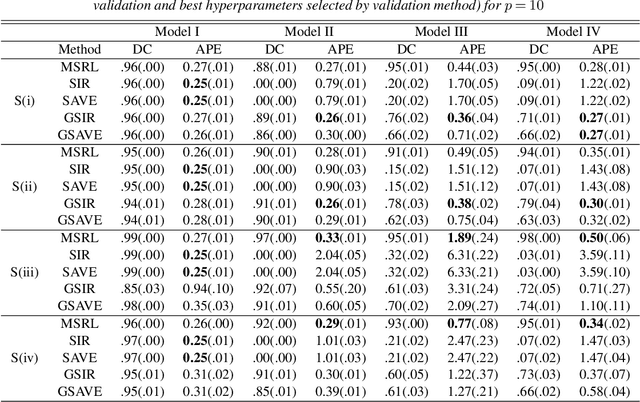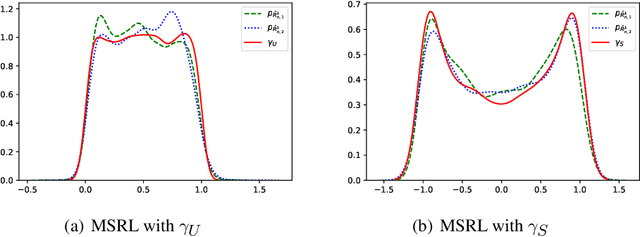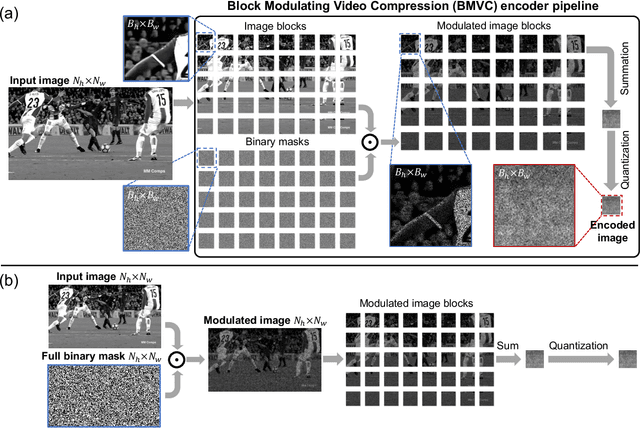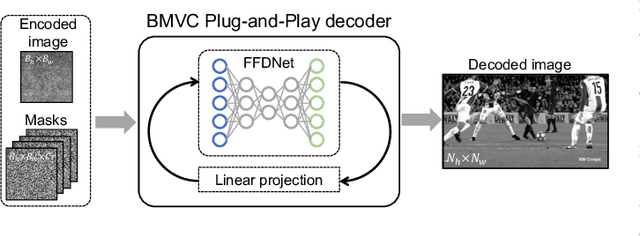Siming Zheng
Sparse Transformer for Ultra-sparse Sampled Video Compressive Sensing
Sep 10, 2025Abstract:Digital cameras consume ~0.1 microjoule per pixel to capture and encode video, resulting in a power usage of ~20W for a 4K sensor operating at 30 fps. Imagining gigapixel cameras operating at 100-1000 fps, the current processing model is unsustainable. To address this, physical layer compressive measurement has been proposed to reduce power consumption per pixel by 10-100X. Video Snapshot Compressive Imaging (SCI) introduces high frequency modulation in the optical sensor layer to increase effective frame rate. A commonly used sampling strategy of video SCI is Random Sampling (RS) where each mask element value is randomly set to be 0 or 1. Similarly, image inpainting (I2P) has demonstrated that images can be recovered from a fraction of the image pixels. Inspired by I2P, we propose Ultra-Sparse Sampling (USS) regime, where at each spatial location, only one sub-frame is set to 1 and all others are set to 0. We then build a Digital Micro-mirror Device (DMD) encoding system to verify the effectiveness of our USS strategy. Ideally, we can decompose the USS measurement into sub-measurements for which we can utilize I2P algorithms to recover high-speed frames. However, due to the mismatch between the DMD and CCD, the USS measurement cannot be perfectly decomposed. To this end, we propose BSTFormer, a sparse TransFormer that utilizes local Block attention, global Sparse attention, and global Temporal attention to exploit the sparsity of the USS measurement. Extensive results on both simulated and real-world data show that our method significantly outperforms all previous state-of-the-art algorithms. Additionally, an essential advantage of the USS strategy is its higher dynamic range than that of the RS strategy. Finally, from the application perspective, the USS strategy is a good choice to implement a complete video SCI system on chip due to its fixed exposure time.
HyperMotion: DiT-Based Pose-Guided Human Image Animation of Complex Motions
May 29, 2025Abstract:Recent advances in diffusion models have significantly improved conditional video generation, particularly in the pose-guided human image animation task. Although existing methods are capable of generating high-fidelity and time-consistent animation sequences in regular motions and static scenes, there are still obvious limitations when facing complex human body motions (Hypermotion) that contain highly dynamic, non-standard motions, and the lack of a high-quality benchmark for evaluation of complex human motion animations. To address this challenge, we introduce the \textbf{Open-HyperMotionX Dataset} and \textbf{HyperMotionX Bench}, which provide high-quality human pose annotations and curated video clips for evaluating and improving pose-guided human image animation models under complex human motion conditions. Furthermore, we propose a simple yet powerful DiT-based video generation baseline and design spatial low-frequency enhanced RoPE, a novel module that selectively enhances low-frequency spatial feature modeling by introducing learnable frequency scaling. Our method significantly improves structural stability and appearance consistency in highly dynamic human motion sequences. Extensive experiments demonstrate the effectiveness of our dataset and proposed approach in advancing the generation quality of complex human motion image animations. Code and dataset will be made publicly available.
MagicTryOn: Harnessing Diffusion Transformer for Garment-Preserving Video Virtual Try-on
May 28, 2025Abstract:Video Virtual Try-On (VVT) aims to simulate the natural appearance of garments across consecutive video frames, capturing their dynamic variations and interactions with human body motion. However, current VVT methods still face challenges in terms of spatiotemporal consistency and garment content preservation. First, they use diffusion models based on the U-Net, which are limited in their expressive capability and struggle to reconstruct complex details. Second, they adopt a separative modeling approach for spatial and temporal attention, which hinders the effective capture of structural relationships and dynamic consistency across frames. Third, their expression of garment details remains insufficient, affecting the realism and stability of the overall synthesized results, especially during human motion. To address the above challenges, we propose MagicTryOn, a video virtual try-on framework built upon the large-scale video diffusion Transformer. We replace the U-Net architecture with a diffusion Transformer and combine full self-attention to jointly model the spatiotemporal consistency of videos. We design a coarse-to-fine garment preservation strategy. The coarse strategy integrates garment tokens during the embedding stage, while the fine strategy incorporates multiple garment-based conditions, such as semantics, textures, and contour lines during the denoising stage. Moreover, we introduce a mask-aware loss to further optimize garment region fidelity. Extensive experiments on both image and video try-on datasets demonstrate that our method outperforms existing SOTA methods in comprehensive evaluations and generalizes to in-the-wild scenarios.
Any-to-Bokeh: One-Step Video Bokeh via Multi-Plane Image Guided Diffusion
May 27, 2025Abstract:Recent advances in diffusion based editing models have enabled realistic camera simulation and image-based bokeh, but video bokeh remains largely unexplored. Existing video editing models cannot explicitly control focus planes or adjust bokeh intensity, limiting their applicability for controllable optical effects. Moreover, naively extending image-based bokeh methods to video often results in temporal flickering and unsatisfactory edge blur transitions due to the lack of temporal modeling and generalization capability. To address these challenges, we propose a novel one-step video bokeh framework that converts arbitrary input videos into temporally coherent, depth-aware bokeh effects. Our method leverages a multi-plane image (MPI) representation constructed through a progressively widening depth sampling function, providing explicit geometric guidance for depth-dependent blur synthesis. By conditioning a single-step video diffusion model on MPI layers and utilizing the strong 3D priors from pre-trained models such as Stable Video Diffusion, our approach achieves realistic and consistent bokeh effects across diverse scenes. Additionally, we introduce a progressive training strategy to enhance temporal consistency, depth robustness, and detail preservation. Extensive experiments demonstrate that our method produces high-quality, controllable bokeh effects and achieves state-of-the-art performance on multiple evaluation benchmarks.
Photography Perspective Composition: Towards Aesthetic Perspective Recommendation
May 27, 2025Abstract:Traditional photography composition approaches are dominated by 2D cropping-based methods. However, these methods fall short when scenes contain poorly arranged subjects. Professional photographers often employ perspective adjustment as a form of 3D recomposition, modifying the projected 2D relationships between subjects while maintaining their actual spatial positions to achieve better compositional balance. Inspired by this artistic practice, we propose photography perspective composition (PPC), extending beyond traditional cropping-based methods. However, implementing the PPC faces significant challenges: the scarcity of perspective transformation datasets and undefined assessment criteria for perspective quality. To address these challenges, we present three key contributions: (1) An automated framework for building PPC datasets through expert photographs. (2) A video generation approach that demonstrates the transformation process from suboptimal to optimal perspectives. (3) A perspective quality assessment (PQA) model constructed based on human performance. Our approach is concise and requires no additional prompt instructions or camera trajectories, helping and guiding ordinary users to enhance their composition skills.
Transformer-Enhanced Variational Autoencoder for Crystal Structure Prediction
Feb 13, 2025Abstract:Crystal structure forms the foundation for understanding the physical and chemical properties of materials. Generative models have emerged as a new paradigm in crystal structure prediction(CSP), however, accurately capturing key characteristics of crystal structures, such as periodicity and symmetry, remains a significant challenge. In this paper, we propose a Transformer-Enhanced Variational Autoencoder for Crystal Structure Prediction (TransVAE-CSP), who learns the characteristic distribution space of stable materials, enabling both the reconstruction and generation of crystal structures. TransVAE-CSP integrates adaptive distance expansion with irreducible representation to effectively capture the periodicity and symmetry of crystal structures, and the encoder is a transformer network based on an equivariant dot product attention mechanism. Experimental results on the carbon_24, perov_5, and mp_20 datasets demonstrate that TransVAE-CSP outperforms existing methods in structure reconstruction and generation tasks under various modeling metrics, offering a powerful tool for crystal structure design and optimization.
Addressing the Accuracy-Cost Tradeoff in Material Property Prediction: A Teacher-Student Strategy
Aug 22, 2023



Abstract:Deep learning has revolutionized the process of new material discovery, with state-of-the-art models now able to predict material properties based solely on chemical compositions, thus eliminating the necessity for material structures. However, this cost-effective method has led to a trade-off in model accuracy. Specifically, the accuracy of Chemical Composition-based Property Prediction Models (CPMs) significantly lags behind that of Structure-based Property Prediction Models (SPMs). To tackle this challenge, we propose an innovative Teacher-Student (T-S) strategy, where a pre-trained SPM serves as the 'teacher' to enhance the accuracy of the CPM. Leveraging the T-S strategy, T-S CrabNet has risen to become the most accurate model among current CPMs. Initially, we demonstrated the universality of this strategy. On the Materials Project (MP) and Jarvis datasets, we validated the effectiveness of the T-S strategy in boosting the accuracy of CPMs with two distinct network structures, namely CrabNet and Roost. This led to CrabNet, under the guidance of the T-S strategy, emerging as the most accurate model among the current CPMs. Moreover, this strategy shows remarkable efficacy in small datasets. When predicting the formation energy on a small MP dataset comprising merely 5% of the samples, the T-S strategy boosted CrabNet's accuracy by 37.1%, exceeding the enhancement effect of the T-S strategy on the whole dataset.
Unfolding Framework with Prior of Convolution-Transformer Mixture and Uncertainty Estimation for Video Snapshot Compressive Imaging
Jun 20, 2023



Abstract:We consider the problem of video snapshot compressive imaging (SCI), where sequential high-speed frames are modulated by different masks and captured by a single measurement. The underlying principle of reconstructing multi-frame images from only one single measurement is to solve an ill-posed problem. By combining optimization algorithms and neural networks, deep unfolding networks (DUNs) score tremendous achievements in solving inverse problems. In this paper, our proposed model is under the DUN framework and we propose a 3D Convolution-Transformer Mixture (CTM) module with a 3D efficient and scalable attention model plugged in, which helps fully learn the correlation between temporal and spatial dimensions by virtue of Transformer. To our best knowledge, this is the first time that Transformer is employed to video SCI reconstruction. Besides, to further investigate the high-frequency information during the reconstruction process which are neglected in previous studies, we introduce variance estimation characterizing the uncertainty on a pixel-by-pixel basis. Extensive experimental results demonstrate that our proposed method achieves state-of-the-art (SOTA) (with a 1.2dB gain in PSNR over previous SOTA algorithm) results. We will release the code.
Deep Sufficient Representation Learning via Mutual Information
Jul 21, 2022



Abstract:We propose a mutual information-based sufficient representation learning (MSRL) approach, which uses the variational formulation of the mutual information and leverages the approximation power of deep neural networks. MSRL learns a sufficient representation with the maximum mutual information with the response and a user-selected distribution. It can easily handle multi-dimensional continuous or categorical response variables. MSRL is shown to be consistent in the sense that the conditional probability density function of the response variable given the learned representation converges to the conditional probability density function of the response variable given the predictor. Non-asymptotic error bounds for MSRL are also established under suitable conditions. To establish the error bounds, we derive a generalized Dudley's inequality for an order-two U-process indexed by deep neural networks, which may be of independent interest. We discuss how to determine the intrinsic dimension of the underlying data distribution. Moreover, we evaluate the performance of MSRL via extensive numerical experiments and real data analysis and demonstrate that MSRL outperforms some existing nonlinear sufficient dimension reduction methods.
Block Modulating Video Compression: An Ultra Low Complexity Image Compression Encoder for Resource Limited Platforms
May 07, 2022



Abstract:We consider the image and video compression on resource limited platforms. An ultra low-cost image encoder, named Block Modulating Video Compression (BMVC) with an encoding complexity ${\cal O}(1)$ is proposed to be implemented on mobile platforms with low consumption of power and computation resources. We also develop two types of BMVC decoders, implemented by deep neural networks. The first BMVC decoder is based on the Plug-and-Play (PnP) algorithm, which is flexible to different compression ratios. And the second decoder is a memory efficient end-to-end convolutional neural network, which aims for real-time decoding. Extensive results on the high definition images and videos demonstrate the superior performance of the proposed codec and the robustness against bit quantization.
 Add to Chrome
Add to Chrome Add to Firefox
Add to Firefox Add to Edge
Add to Edge